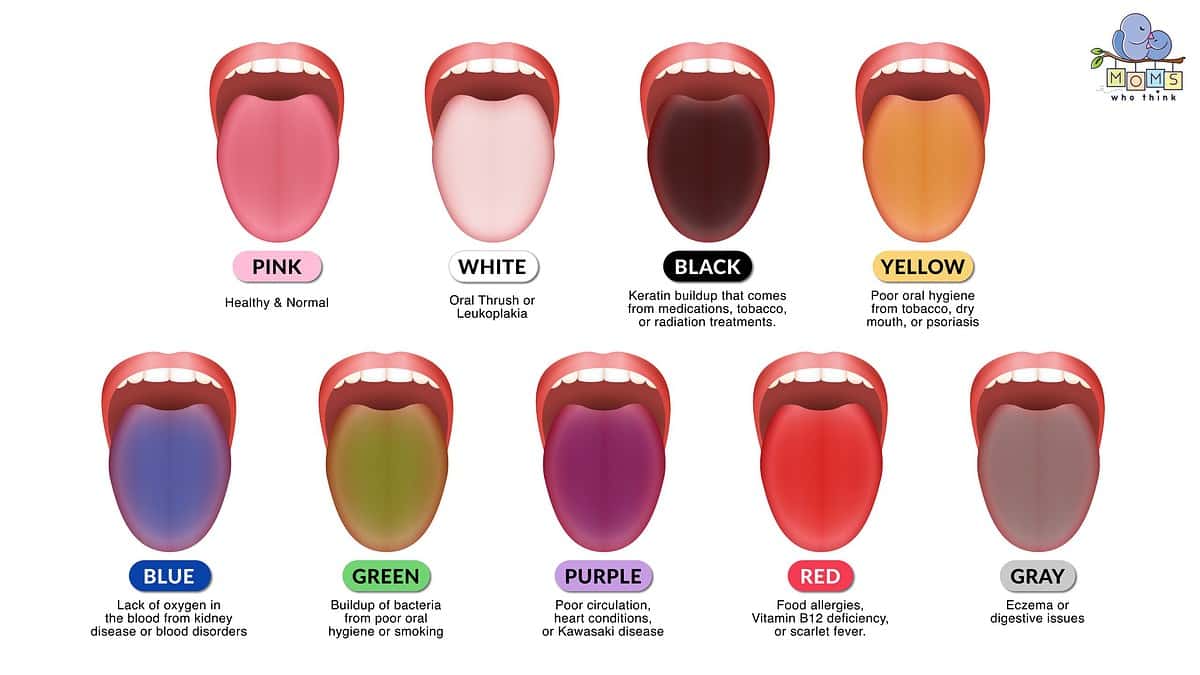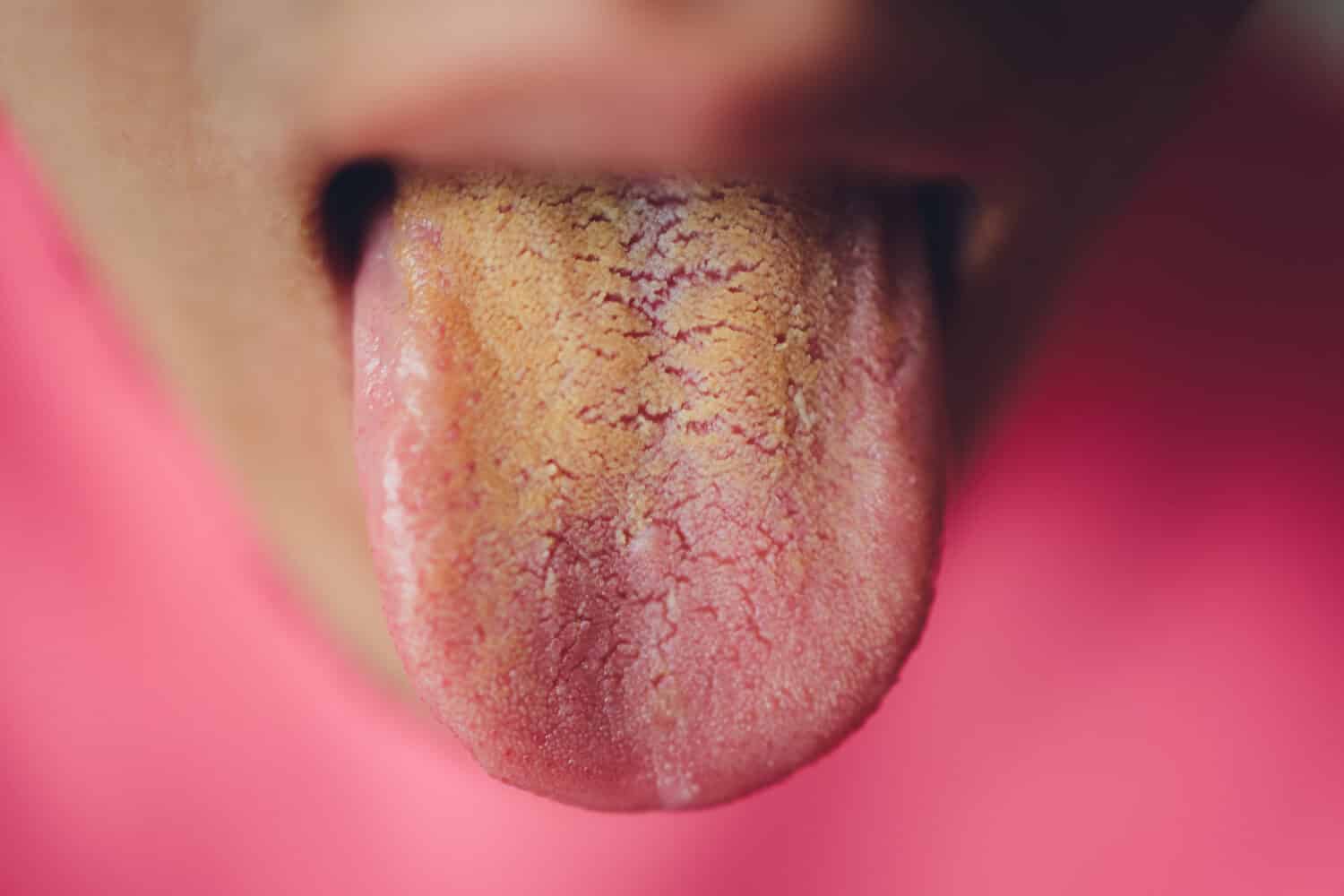When we look at our tongues, we usually see them as healthy and pink with tiny bumps on the surface. But what does it mean if your tongue looks different? What if your tongue has a different color on the surface?
The color of your tongue could reveal a lot about your general health. It's important to pay attention to any changes as different colors could mean you have an underlying health condition. Here's everything you need to know about different tongue colors, complete with a chart for reference.
What the Color of Your Tongue Says About Your Health
Sometimes you may find that the color of your tongue changes. This is common and can simply be due to poor oral hygiene. However, it could also be a sign of something more serious. Identifying the color of your tongue and what it means can help you determine when to seek medical help.
Let's take a closer look at some of the most common tongue discolorations and what they mean.

This tongue color chart shows common discolorations to pay attention to.
©
Pink
A healthy and normal tongue ranges in color from light to dark pink. You may also notice small bumps on the surface. According to the Cleveland Clinic, these bumps are a combination of tastebuds and papilla. They help with taste and sensation and are normal when small and uniform in shape. We'll dive into what it means to have larger bumps on your tongue later, but for now, just know that small bumps and a pink tongue are considered healthy.
White
While your healthy and pink tongue may have a surface that appears whitish and translucent, obvious white patches or lines are something to watch out for. White patches can indicate oral thrush which is a fungal infection. This can usually be cured with an antifungal medication.
If you have white lines, this can be an indication of leukoplakia, a benign condition. According to Healthline, leukoplakia usually goes away on its own and is harmless. However, serious causes can mean oral cancer, so it's important to visit a medical professional if you think you have leukoplakia.
Black
A black tongue is also sometimes given the name “black hairy tongue.” While it may look alarming, the Mayo Clinic states that this condition is typically harmless and painless. It can be the result of keratin buildup that comes from medications, tobacco use, or even radiation treatments.
Black hairy tongue can also be caused by the buildup of dead skin cells or bacteria on the taste buds and papillae on your tongue.
Yellow
If your tongue appears yellow, this is usually due to poor oral hygiene. If you smoke or use tobacco, this can also create a yellowish appearance on your tongue. Additionally, a yellow tongue can be the result of a constant dry mouth or psoriasis.
A yellow tongue is not normally something you need to seek medical care for. If you're a tobacco user, cutting back or quitting can help to eliminate the discoloration. The Mayo Clinic also says that gently brushing your tongue with a solution that's 5 parts water and 1 part hydrogen peroxide once a day can help, too.

A yellow tongue is most often caused by poor oral hygiene or tobacco use.
©Vershinin89/Shutterstock.com
Blue
A blue tongue can indicate a lack of oxygen in your blood. This lack of oxygen can normally be tied back to blood disorders or kidney disease. It can also be a sign of Cyanosis which the Cleveland Clinic identifies as a condition where your skin, lips, and/or nails all turn a blueish hue. While Cyanosis is also caused by a lack of oxygen in the blood, it may require medical treatment.
Green
A green-looking tongue is similar to a yellow one. It's often the result of poor oral hygiene and can be caused by smoking. It also indicates the buildup of bacteria which can be fixed by regularly brushing and caring for your teeth.
Sometimes a green tongue can also mean your mouth has a fungal or yeast overgrowth. Antifungal medications can help your tongue return to a normal, healthy, pink color.
Purple
While a purple tongue is less commonly seen, it can indicate a few health concerns. A purple tongue can mean your body has poor circulation or you're experiencing heart problems.
In rare cases, a bright purple tongue can be an indication of Kawasaki disease. This heart condition often occurs in children under the age of 5 according to Johns Hopkins Medicine. It can also cause a high fever as a child's immune system begins attacking red blood cells, affecting coronary arteries. Thankfully, this condition can be treated when caught right away.
Red
A red tongue will appear darker in color than a healthy pink one. This can be there result of a Vitamin B deficiency which can be resolved through supplementation. Sometimes, a red tongue can also indicate something more serious like food allergies, eczema, or scarlet fever (a mild illness that can cause a rash, fever, and sore throat). Additionally, Kawasaki disease can also cause a tongue to turn red with bumps and is sometimes referred to as “strawberry tongue.”
Gray
When your tongue turns grayish in color, this can be the result of a few different conditions. It may simply indicate that you have digestive issues like an ulcer or eczema. If you have gray/white patches, this can tie back to leukoplakia or oral thrush as well.
Additionally, people who have liver disease or diabetes may sometimes develop a grayish color on their tongue.
Other Tongue Conditions to Pay Attention To
While the color of your tongue can help you better understand what's going on with your overall health, there are a few other tongue conditions to pay attention to:
- Larger bumps that are be the result of canker sores, cold sores, oral thrush, or tongue cancer.
- A fissured tongue (which looks like deep grooves on the surface) that has formed due to psoriasis or other conditions.
- Any sort of pain or burning feeling that doesn't go away after a few days, as this can indicate a larger health concern.
How to Take Good Care of Your Oral Health
A few of the discolorations we've discussed are simply the result of poor oral care. Brushing, flossing, and taking good care of your teeth, gums, tongue, and mouth can alleviate some tongue discolorations. The American Dental Association recommends:
- Brushing twice a day
- Flossing daily
- Eating a healthy diet with reduced sugar consumption
- Regular visits to your dentist
- Quitting tobacco use
- Drinking water with fluoride

The ADA recommends brushing twice daily to promote healthy oral hygiene and avoid tongue discoloration.
©Prostock-studio/Shutterstock.com
When to See a Doctor
While proper oral hygiene is important, your tongue's discoloration may be the result of an underlying health condition that requires medical assistance. If your tongue discoloration won't go away or changes in color, you may want to visit your doctor. Additionally, if you see changes in size, shape, or coating, it might be time to seek medical advice.
Large bumps that don't go away are also a reason to visit your doctor. While canker sores and cold sores are common, a large bump that doesn't go away after a few days may indicate a larger health concern like cancer.
Even if you think your tongue discoloration may not be a major health issue, it can be beneficial to visit with your healthcare practitioner to give you peace of mind or discuss options to get your tongue back to its healthy, pink color.
Final Thoughts
To get rid of your tongue's discoloration, you'll need to treat the underlying cause. Each color listed above can give you a good starting point, but it's always smart to seek medical care if you're concerned or need more answers. Most often, simple oral hygiene changes, diet alterations, or antifungal medications can treat common tongue discoloration issues.
The image featured at the top of this post is ©Kyrylo Ryzhov/Shutterstock.com
